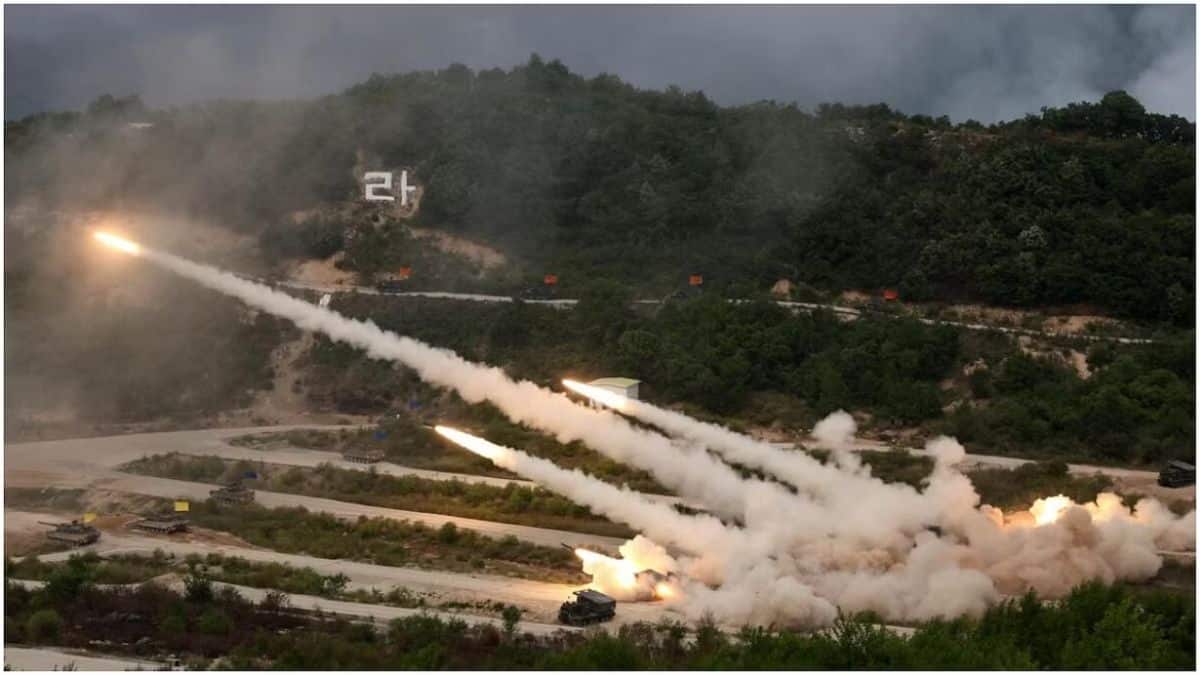 Image Credits - Deccan Herald
Image Credits - Deccan Herald
President Yoon Suk Yeol oversaw the largest-ever joint live-fire drills, where South Korean and U.S. forces conducted the Combined Joint Live-Fire Exercise. This marked the first such exercise in six years and occurred at the Seungjin Fire Training Field in Pocheon, situated near the inter-Korean border. The event served as a commemoration for the 70th anniversary of the South Korea-U.S. alliance and the 75th anniversary of South Korea’s armed forces.
The President pledged to safeguard the nation through a strong security stance and realistic training. The joint live-fire exercise consisted of two parts. The first part focused on responding to North Korea’s nuclear and missile threats and deterring a potential attack. The second part showcased the allied forces’ capabilities for counterattacks.
The drills involved over 610 military assets, including F-35A fighters and K9 self-propelled howitzers from South Korea, and F-16 fighter jets and Gray Eagle drones from the U.S. Over 2,500 troops from 71 units participated in this significant military exercise.
Approximately 2,000 individuals, including 300 “citizen observers” and Defense Minister Lee Jong-sup, as well as the chiefs of staff of the Army, Navy, and Air Force, and South Korea-U.S. Combined Forces Command chief Gen. Paul LaCamera, witnessed the drills. The combined exercise, held five times in total, concluded with the last round on Thursday.
The exercises led by President Yoon Suk Yeol were designed to assess the capacity for combined and joint operations, to achieve “peace through strength” via practical manoeuvres and live-fire training. The scenario chosen was a North Korean provocation, and these drills were characterized as the most extensive live-fire exercises conducted in collaboration with the United States. The emphasis was on demonstrating the readiness and effectiveness of the joint forces in response to potential provocations and threats from North Korea.
North Korea’s Provocations
The South Korean Joint Chiefs of Staff reported the detection of two short-range ballistic missiles fired by North Korea towards the East Sea from the area of Sunan (near Pyongyang) between 1925 and 1937 hours. These missiles travelled 780 kilometres before impacting the East Sea. This was the first missile launch by North Korea in 63 days since a test-fire of the new Hwasong-18 solid-fueled intercontinental ballistic missile (ICBM).
In response, the national security advisors of South Korea, the United States, and Japan issued a joint statement condemning the North Korean launches. They emphasized that these launches violated multiple United Nations Security Council resolutions and posed a threat to regional and global peace, security, and non-proliferation efforts. The advisors called for full implementation of UN Security Council resolutions related to North Korea and expressed a commitment to continued cooperation among Japan, South Korea, and the U.S., despite provocations.
Before the launches, North Korea issued a “strong warning” through the Korean Central News Agency, attributed to a Ministry of National Defence spokesperson. The warning denounced the South Korea-U.S. live-fire exercises as provocative and irresponsible, emphasizing that North Korea’s armed forces would fully counter any demonstrative moves and provocations by the enemy.
On the 24th anniversary of the First Battle of Yeonpyeong Island, President Yoon posted a message on Facebook, stressing a resolute response to North Korea’s provocations. He emphasized the need for overwhelming force to achieve true peace, rejecting a situation where the country would be begging before its enemy.
The U.S. Impact
The recent live-fire drills conducted by South Korea and the United States have occurred in the context of South Korean President Yoon Suk Yeol’s visit to the White House last month. During this visit, both leaders, President Yoon and U.S. President Joe Biden, signed a declaration affirming their commitment to enhancing nuclear deterrence coordination between the two nations. The declaration was crucial in reassuring South Korea that it remains under the protection of the U.S. nuclear umbrella, thereby diminishing the necessity for South Korea to pursue its nuclear arsenal.
This diplomatic development was widely regarded as a significant achievement for the United States, strengthening its ties with South Korea and advancing nuclear nonproliferation efforts. The commitment to nuclear deterrence coordination is part of a broader strategy to reinforce the security partnership between the two allies and maintain stability in the region.
From a U.S. perspective, an expanded and strengthened alliance with South Korea serves several strategic interests. These include:
Regional Stability: A strong alliance with South Korea contributes to stability in the Asia-Pacific region, promoting peace and security.
Counterbalance to North Korea: The alliance helps counter the threat posed by North Korea’s nuclear and missile activities, fostering regional security.
Deterrence against Aggression: A robust U.S.-South Korea alliance acts as a deterrent against potential aggression, enhancing the security environment.
Strategic Positioning: South Korea’s geostrategic location is of importance to the U.S. military presence in the region, allowing for effective responses to regional challenges.
Overall, the strengthened U.S. interest in South Korea reflects a commitment to regional security, diplomatic cooperation, and the pursuit of shared strategic objectives in the Asia-Pacific.
